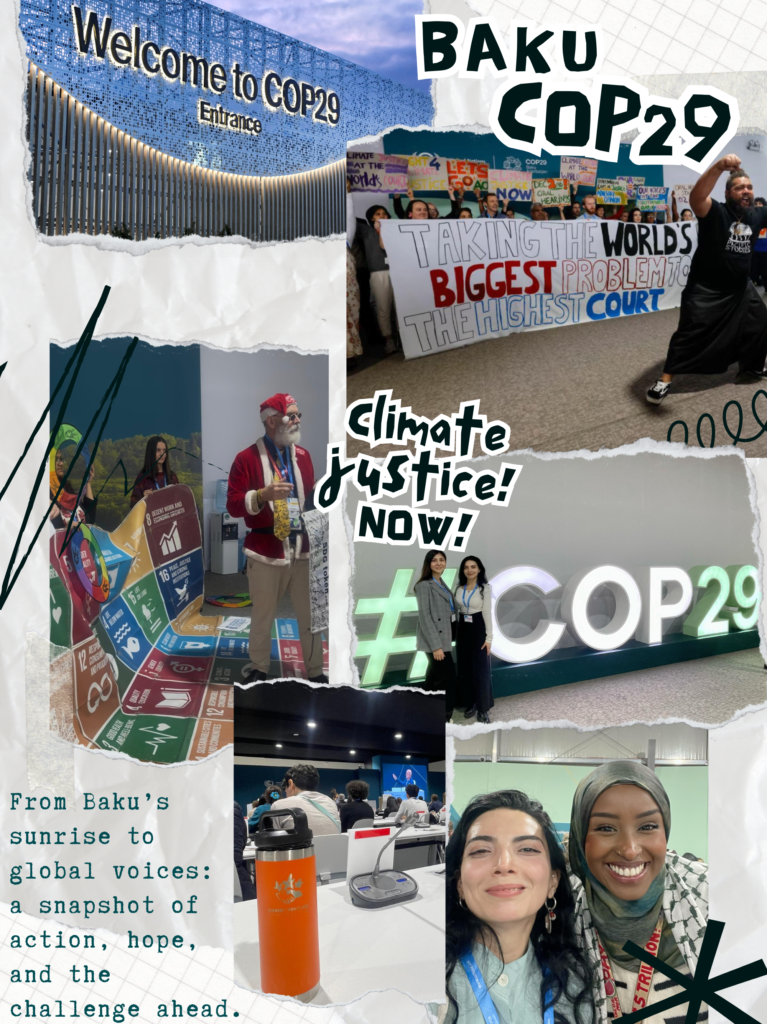By Nazila Aliyeva
Walking into the COP29 venue—the Olympic Stadium in Baku—early in the morning, I paused to take it all in. The first rays of sunlight lit up the city’s skyline, and overhead, birds flew gracefully, cutting through the crisp air. Around me, people from all over the world arrived—some in suits, others in colorful traditional outfits, speaking a mix of languages. The energy was incredible, but so was the weight of what brought us all here: the urgent need to address the climate crisis.
As I stood there, I couldn’t help but wonder: How do we make sense of such a huge gathering? How do we turn these big conversations into real change for our planet?
A City of Contrasts, A Conference of Challenges
Baku’s blend of old and new—the ancient walls of the Old City alongside futuristic skyscrapers, felt like a reflection of the conference itself—a blend of past, present, and future challenges. Inside the venue, the discussions were equally diverse. Scientists shared data, indigenous leaders spoke about their lived experiences, and negotiators debated pathways forward.
One session that stuck with me featured representatives from small island nations. Their message was simple and urgent: rising sea levels are destroying their homes. “For us,” one speaker said, “every delay in action means another piece of our land disappears under the ocean.” The room went silent. Moments like these reminded me why these conferences matter, even when they feel overwhelming. Later, I found myself joining a protest inside the venue, chanting alongside others for Climate Justice Now! Moments like these reignited my faith in collective action.
After long and tense negotiations, countries agreed on new rules for international carbon trading under Article 6.4 of the Paris Agreement. This could bring much-needed funding to countries most affected by climate change. Yet the financial gap remained a sore point.
Discussions on setting a new financial target replaced the outdated $100 billion annual commitment, culminating in a pledge to mobilize $300 billion annually by 2035. While this tripling of funds was hailed as progress, developing nations and climate advocates criticized it as insufficient. They argue that at least $1.3 trillion annually is required to effectively combat climate change. Moreover, concerns arose over the reliance on loans rather than grants, which could increase debt burdens for already struggling economies.
Despite growing global pressure, there was no strong agreement to phase out fossil fuels. Outside the venue, activists held signs that said, “No Time Left for Fossils,” but inside the negotiating rooms, the progress was limited.
For the first time, a dedicated Tourism Day was held at COP29, emphasizing the sector’s role in addressing climate change. Discussions centered on adopting sustainable practices and reducing the tourism industry’s carbon footprint. Ideas included promoting low-impact travel, incentivizing eco-friendly accommodations, and empowering local communities to take ownership of sustainable tourism initiatives.
As someone passionate about rural and ecotourism, I found these discussions inspiring. They underscored how tourism can be both a challenge and a solution in the climate crisis.
While COP29 achieved progress in some areas, it underscored the ongoing challenges in aligning global policies with climate goals.
Looking ahead
Each morning and the evening on my way to and from the venue, I watched birds flying freely above the stadium. It reminded me of the balance we’re striving for—a world where humans and nature can coexist sustainably. But achieving that balance takes more than hope; it demands commitment, cooperation, and action.

